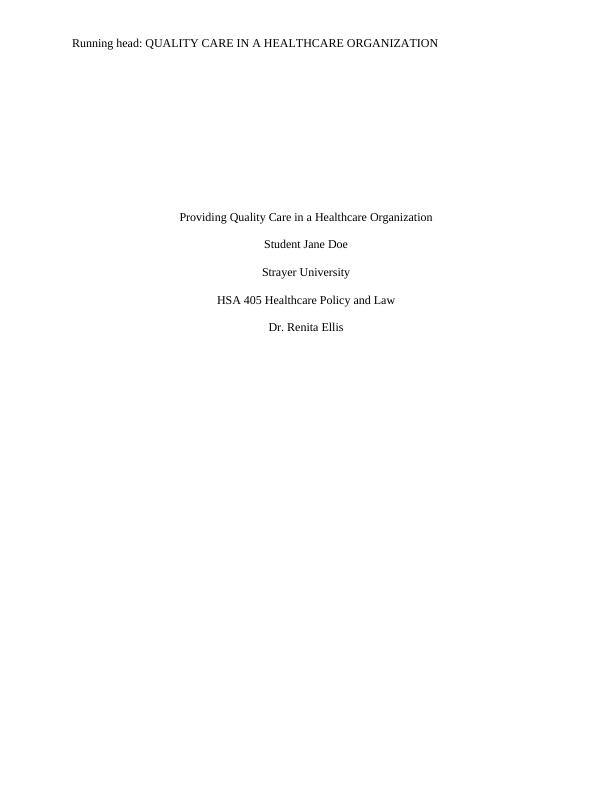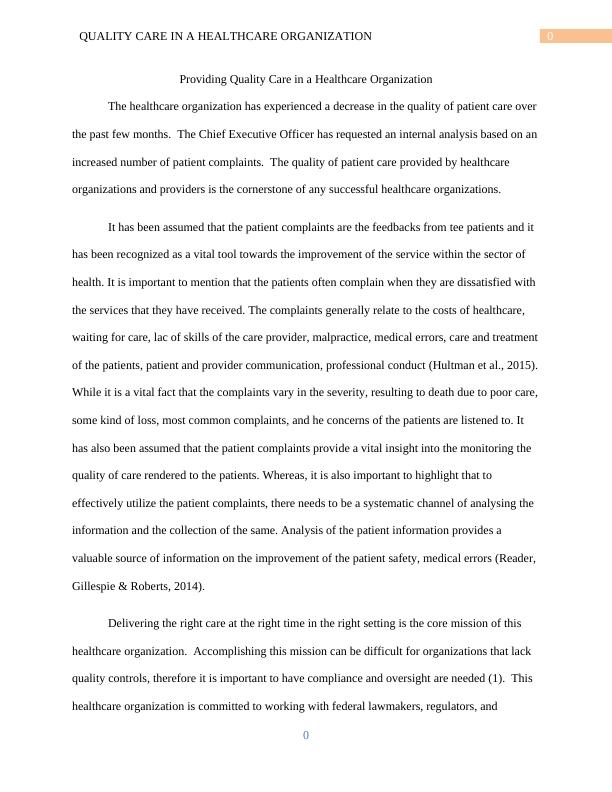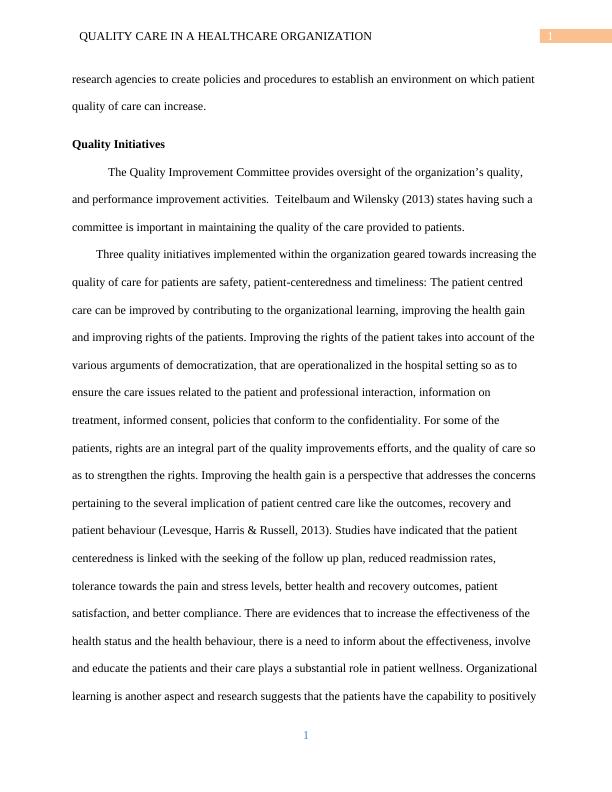Providing Quality Care in a Healthcare Organization
Added on 2023-04-19
12 Pages3243 Words97 Views
Running head: QUALITY CARE IN A HEALTHCARE ORGANIZATION
Providing Quality Care in a Healthcare Organization
Student Jane Doe
Strayer University
HSA 405 Healthcare Policy and Law
Dr. Renita Ellis
Providing Quality Care in a Healthcare Organization
Student Jane Doe
Strayer University
HSA 405 Healthcare Policy and Law
Dr. Renita Ellis

0QUALITY CARE IN A HEALTHCARE ORGANIZATION
Providing Quality Care in a Healthcare Organization
The healthcare organization has experienced a decrease in the quality of patient care over
the past few months. The Chief Executive Officer has requested an internal analysis based on an
increased number of patient complaints. The quality of patient care provided by healthcare
organizations and providers is the cornerstone of any successful healthcare organizations.
It has been assumed that the patient complaints are the feedbacks from tee patients and it
has been recognized as a vital tool towards the improvement of the service within the sector of
health. It is important to mention that the patients often complain when they are dissatisfied with
the services that they have received. The complaints generally relate to the costs of healthcare,
waiting for care, lac of skills of the care provider, malpractice, medical errors, care and treatment
of the patients, patient and provider communication, professional conduct (Hultman et al., 2015).
While it is a vital fact that the complaints vary in the severity, resulting to death due to poor care,
some kind of loss, most common complaints, and he concerns of the patients are listened to. It
has also been assumed that the patient complaints provide a vital insight into the monitoring the
quality of care rendered to the patients. Whereas, it is also important to highlight that to
effectively utilize the patient complaints, there needs to be a systematic channel of analysing the
information and the collection of the same. Analysis of the patient information provides a
valuable source of information on the improvement of the patient safety, medical errors (Reader,
Gillespie & Roberts, 2014).
Delivering the right care at the right time in the right setting is the core mission of this
healthcare organization. Accomplishing this mission can be difficult for organizations that lack
quality controls, therefore it is important to have compliance and oversight are needed (1). This
healthcare organization is committed to working with federal lawmakers, regulators, and
0
Providing Quality Care in a Healthcare Organization
The healthcare organization has experienced a decrease in the quality of patient care over
the past few months. The Chief Executive Officer has requested an internal analysis based on an
increased number of patient complaints. The quality of patient care provided by healthcare
organizations and providers is the cornerstone of any successful healthcare organizations.
It has been assumed that the patient complaints are the feedbacks from tee patients and it
has been recognized as a vital tool towards the improvement of the service within the sector of
health. It is important to mention that the patients often complain when they are dissatisfied with
the services that they have received. The complaints generally relate to the costs of healthcare,
waiting for care, lac of skills of the care provider, malpractice, medical errors, care and treatment
of the patients, patient and provider communication, professional conduct (Hultman et al., 2015).
While it is a vital fact that the complaints vary in the severity, resulting to death due to poor care,
some kind of loss, most common complaints, and he concerns of the patients are listened to. It
has also been assumed that the patient complaints provide a vital insight into the monitoring the
quality of care rendered to the patients. Whereas, it is also important to highlight that to
effectively utilize the patient complaints, there needs to be a systematic channel of analysing the
information and the collection of the same. Analysis of the patient information provides a
valuable source of information on the improvement of the patient safety, medical errors (Reader,
Gillespie & Roberts, 2014).
Delivering the right care at the right time in the right setting is the core mission of this
healthcare organization. Accomplishing this mission can be difficult for organizations that lack
quality controls, therefore it is important to have compliance and oversight are needed (1). This
healthcare organization is committed to working with federal lawmakers, regulators, and
0

1QUALITY CARE IN A HEALTHCARE ORGANIZATION
research agencies to create policies and procedures to establish an environment on which patient
quality of care can increase.
Quality Initiatives
The Quality Improvement Committee provides oversight of the organization’s quality,
and performance improvement activities. Teitelbaum and Wilensky (2013) states having such a
committee is important in maintaining the quality of the care provided to patients.
Three quality initiatives implemented within the organization geared towards increasing the
quality of care for patients are safety, patient-centeredness and timeliness: The patient centred
care can be improved by contributing to the organizational learning, improving the health gain
and improving rights of the patients. Improving the rights of the patient takes into account of the
various arguments of democratization, that are operationalized in the hospital setting so as to
ensure the care issues related to the patient and professional interaction, information on
treatment, informed consent, policies that conform to the confidentiality. For some of the
patients, rights are an integral part of the quality improvements efforts, and the quality of care so
as to strengthen the rights. Improving the health gain is a perspective that addresses the concerns
pertaining to the several implication of patient centred care like the outcomes, recovery and
patient behaviour (Levesque, Harris & Russell, 2013). Studies have indicated that the patient
centeredness is linked with the seeking of the follow up plan, reduced readmission rates,
tolerance towards the pain and stress levels, better health and recovery outcomes, patient
satisfaction, and better compliance. There are evidences that to increase the effectiveness of the
health status and the health behaviour, there is a need to inform about the effectiveness, involve
and educate the patients and their care plays a substantial role in patient wellness. Organizational
learning is another aspect and research suggests that the patients have the capability to positively
1
research agencies to create policies and procedures to establish an environment on which patient
quality of care can increase.
Quality Initiatives
The Quality Improvement Committee provides oversight of the organization’s quality,
and performance improvement activities. Teitelbaum and Wilensky (2013) states having such a
committee is important in maintaining the quality of the care provided to patients.
Three quality initiatives implemented within the organization geared towards increasing the
quality of care for patients are safety, patient-centeredness and timeliness: The patient centred
care can be improved by contributing to the organizational learning, improving the health gain
and improving rights of the patients. Improving the rights of the patient takes into account of the
various arguments of democratization, that are operationalized in the hospital setting so as to
ensure the care issues related to the patient and professional interaction, information on
treatment, informed consent, policies that conform to the confidentiality. For some of the
patients, rights are an integral part of the quality improvements efforts, and the quality of care so
as to strengthen the rights. Improving the health gain is a perspective that addresses the concerns
pertaining to the several implication of patient centred care like the outcomes, recovery and
patient behaviour (Levesque, Harris & Russell, 2013). Studies have indicated that the patient
centeredness is linked with the seeking of the follow up plan, reduced readmission rates,
tolerance towards the pain and stress levels, better health and recovery outcomes, patient
satisfaction, and better compliance. There are evidences that to increase the effectiveness of the
health status and the health behaviour, there is a need to inform about the effectiveness, involve
and educate the patients and their care plays a substantial role in patient wellness. Organizational
learning is another aspect and research suggests that the patients have the capability to positively
1

2QUALITY CARE IN A HEALTHCARE ORGANIZATION
contribute towards the healthcare improvements and also through the non-clinical aspects of the
care and the care environment. Quality improvement efforts play a major role in overcoming the
barriers towards including the contribution of the patient and also in the process of organizational
learning (Kitson et al., 2013). This will be measured at the patient level and the usually assessed
through the standardized questionnaires, and in-depth interviews conducted within the focus
groups so as to explore the views of the patients.
Proper management of scheduling of the appointments play a major role towards the
achievement of accessibility and timelines in the healthcare system. However, it is important to
note that the majority of the scheduling systems are defective and the unattended appointments
actually represent the less utilization of the precious resources of healthcare. There are many
factors that affect the performance of the appointment scheduling and it includes the experience
level of the scheduling staff, available information technology, preferences of the provider and
the patients, variability of the service time and also the arrival time, performance of the
appointment scheduling. Thus, it is essential to manage the vital and important bottlenecks in the
business and industrial domains. The hospital need to develop the dynamic procedures and
policies pertaining to the patient appointment (Cubillas et al., 2014).
The five patient centred strategy that will improve safety of the patient include the
provisions of allowing the patients to access the patient data pertaining to clinical notes and EHR
data; care for the environment existing within the hospital; creation of a safe patient experience;
creation of a timely and a simple appointment scheduling; encouraging the caregiver and family
engagement (Pulvirenti, McMillan & Lawn, 2014).
Healthcare Cost Reduction Factors
2
contribute towards the healthcare improvements and also through the non-clinical aspects of the
care and the care environment. Quality improvement efforts play a major role in overcoming the
barriers towards including the contribution of the patient and also in the process of organizational
learning (Kitson et al., 2013). This will be measured at the patient level and the usually assessed
through the standardized questionnaires, and in-depth interviews conducted within the focus
groups so as to explore the views of the patients.
Proper management of scheduling of the appointments play a major role towards the
achievement of accessibility and timelines in the healthcare system. However, it is important to
note that the majority of the scheduling systems are defective and the unattended appointments
actually represent the less utilization of the precious resources of healthcare. There are many
factors that affect the performance of the appointment scheduling and it includes the experience
level of the scheduling staff, available information technology, preferences of the provider and
the patients, variability of the service time and also the arrival time, performance of the
appointment scheduling. Thus, it is essential to manage the vital and important bottlenecks in the
business and industrial domains. The hospital need to develop the dynamic procedures and
policies pertaining to the patient appointment (Cubillas et al., 2014).
The five patient centred strategy that will improve safety of the patient include the
provisions of allowing the patients to access the patient data pertaining to clinical notes and EHR
data; care for the environment existing within the hospital; creation of a safe patient experience;
creation of a timely and a simple appointment scheduling; encouraging the caregiver and family
engagement (Pulvirenti, McMillan & Lawn, 2014).
Healthcare Cost Reduction Factors
2

End of preview
Want to access all the pages? Upload your documents or become a member.
Related Documents
Improvement of the quality services in the healthcare unitlg...
|5
|991
|419
Healthcare Quality Management Assessment 2022lg...
|14
|3193
|9
Assignment on Healthcare Safety Programlg...
|4
|375
|11
Patient Safety Indicators: Medication Errorslg...
|19
|4317
|297
Transformation of The Joint Commission based on HMD recommendationslg...
|12
|892
|87
Leadership in Healthcare: Strategies for Improving Quality of Carelg...
|6
|1138
|131
